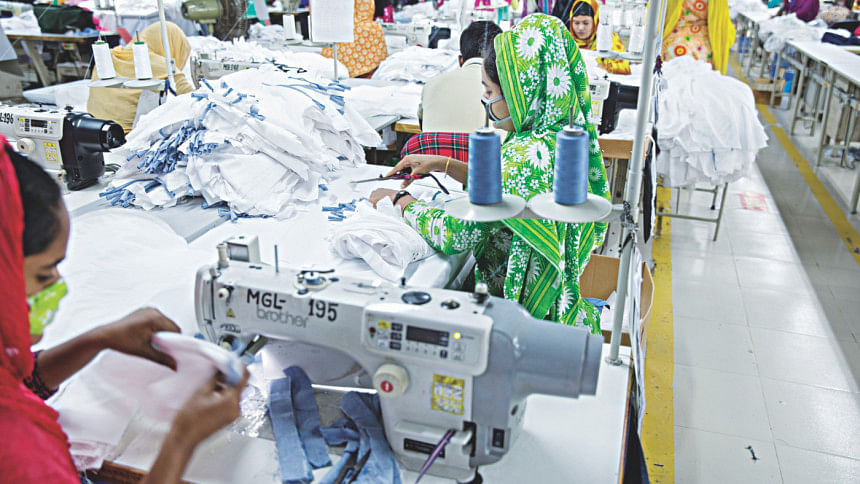A walk towards prosperity

I woke up with a longing that rainy morning, my plants were all beaming in the rain drenched sunlight, and the air was thick with a muddy, grassy scent and I wanted to go on a long drive; in fact, I wanted to drive to an unknown remote place and buy fresh organic vegetables. I must admit, in my whimsical moods, I get to discover so much. This time, I headed towards Doguri, near Mirzapore, Gazipur.
Right after you cross the Joydebpur crossing, the outskirts of Dhaka paint a peaceful picture, the sides of the roads are surrounded by Bhawal national forest; the jungle green Debdaru and Shaal trees soaring high seems like they are reaching for the grey clouds. The drive through the wide four-lane roads, with not a bump, was indeed heavenly — I stopped at an obscure lush village, surrounded by paddy fields and bamboo thickets, for a cup of ginger tea.
The unknown hamlet was a picture-perfect Bangladeshi village; cattle in the sheds, backyards of houses full of sprouting winter greens, children played with clucking chickens and quacking ducks. I got my fill of fresh vegetables, but also got a unique peek at of our RMG sector while sipping tea at the roadside tong.
I was curious as to where the men and women were hurrying to, through the narrow mud lanes, that early in the morning. They were queuing up at the factory entrance to punch their ID cards at 8 o'clock on the dot. Interestingly enough, you see children hanging on to their working mums, as they place the youngsters at the day care centre in the factory vicinity; you also see pigtailed children in chequered pinafores and black shoes, running to class, also within the premises of the MG Niche Stitch factory, built four years ago in the village, and now changing the very fabric of it.
This busy scenario made me wonder how our RMG sector, something our economy depends on so much, is faring. The factories are now shifting to tranquil, and somewhat remote villages, on the peripherals of Dhaka city, thus improving the overall economic situation through backward linkage.
Workers come from far off areas like Jamalpur, Mymensingh, and even Dhaka city, and rent houses near the factories. With the factories in the village, infrastructure has seen rapid improvement, such as better roads are being built, electricity supply has become more stable, and as a result, house rent has increased, new shops have opened, groceries are thriving, and new schools have been built. A new factory boosts so many other businesses and services around it.
This one industry is helping the economy by providing jobs and income by promoting linkages to other industries in Bangladesh, which in turn, profit directly and indirectly from the growth of the textile industry.
The stories of the men and women queuing at the factory gate that early in the morning, add up to a perfectly compliant factory scenario in Bangladesh, and represents the country's robust economy. There are 4,500 such factories in Bangladesh, where over 4.5 million are employed, changing their lifestyle and destiny, while reshaping the economic scenario of the entire textile and garment industry in the country.
To get a really good picture of this situation, I found some experts to shed some more light on my thoughts.
"Trade financing or trade related service sectors are catering to the growing industrial sector of Bangladesh, and the formal garment industrialisation in Bangladesh. Service and industry sectors are expanding, creating more work opportunities, and most of it is linked with the textile and garment industry," said Nur Mohammad Amin Rasel, Additional Secretary, Trade Promotion, Bangladesh Garment Manufacturers and Exporters Association (BGMEA).
This decade, the country has witnessed an average of six percent growth per annum, and the impact can be seen in the redistribution of the economic sectors' contribution to the Gross Domestic Product (GDP) viz agriculture, industry, and service sector.
A large chunk of this growth was achieved on the coattails of the growth spearheaded by the ready-made garment sector, which has emerged stronger, more well-defined and modernised, from the tragedies that befell it for earlier oversights.
This industry has cumulative experience of over 40 years, and especially after the Rana Plaza incident six years ago, almost all factories have implemented strict compliance policies. "The reality is that Bangladesh is a poor LDC country, and the garment workers themselves are also poor, and the reason why foreign buyers outsources their production is because the cost of labour here is cheap. Out of Bangladesh's total population, only 60 million are economically active, and just 4.5 million are in the garment sector. Rickshaw pullers, garage workers, domestic helps; there are so many other sectors, and you cannot isolate just one sector to keep the economy robust. This sector employs people, and has made an impact on the GDP — 84 percent of export earnings create a lot of employment. Labour narratives changed, deficit of trust among workers and owners has been addressed, and rectified. This tendency to overgeneralise or amplify a situation by buyers now needs to be addressed," explained Dr Rubana Huq, President, Bangladesh Garment Manufacturers and Exporters Association (BGMEA).
Nazma Akter, the founder and General Secretary of Awaj Foundation, has been fighting to improve workers' rights, especially female workers in the garment sector in Bangladesh, for over 32 years. She claimed that the RMG sector in Bangladesh provides employment opportunities to mostly unskilled, poor women.
"We need to co-brand the tag 'Made in Bangladesh' and women empowerment, and in my opinion, when the owners and workers have a relationship of transparency, fair accountability, respect, and value, progress happens. The buyers still have a colonisation attitude, because our owners sell our labour at cheap wages. They must negotiate with the buyers, keeping a worker's wage in mind. Owners can make profit, but they must get green prices," Nazma stressed, adding that decent working conditions do not imply only infrastructure, but rather, workers' welfare and livelihood as well," Nazma said.
After seeing such a rush that early in the morning, in that quaint rural corner, I just could not help but dig deep, to know that the RMG industry, aside from helping boost the economy, is also treating them right for the amount of work and sincerity they show, and after talking to experts in the field, I am happy to know that all is well, and whatever lacking we do have, is being addressed as we speak. I love to hear their positive stories and see their positive smiles. For as long as they take that walk towards their work, we can boast a robust socio-economic standing, especially those in the lifestyle business.
Photo: Sazzad Ibne Sayed

 For all latest news, follow The Daily Star's Google News channel.
For all latest news, follow The Daily Star's Google News channel. 



Comments